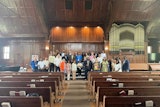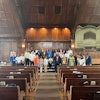Roll over, Melvil Dewey. Behold the 21st-century college library.
Hundreds of schools, from Ivy League universities to community colleges, have remade their libraries as colorful hubs of college life. Gone are bound journals, miles of musty books and rules governing proper behavior. In are on-site cafes, group study areas where talking is encouraged, 24-hour access and sofas designed for dozing.
The welcoming touches reflect the latest thinking about the millennial generation’s learning habits and recognition that students with laptops and Wi-Fi access can study anywhere, said Julie Garrison, Western Michigan University dean of libraries.
“We used to think about library design always in terms of the books. We were about first collections, then readers,” Garrison said. “There is less of a need to protect a print collection in the way we did when it was the only way to get information, and we realized that if we let people bring in food and drink, they would stay longer.”
As books have given way to network bandwidth, college libraries also are being equipped with media production labs, high-tech “maker spaces” where students can use 3-D printers and laser cutters, and data visualization walls where they can show off projects. At many campuses, information technology professionals take seats alongside reference librarians.
“There really has been a complete shift in the idea of what a library is doing on a campus, a shift from a concept of a place for preserving knowledge to a space for creation and collaboration,” said Katherine Bergeron, president of Connecticut College in New London.
The college’s Charles E. Shain Library was built in 1976 with only small windows to help protect materials from sunlight. It was recently overhauled to emphasize natural light and more communal space.
Christopher Stewart, an assistant professor at Dominican University in Illinois who researches academic libraries, said the creature comforts and technology have supplemented, not supplanted, the qualities that alumni remember from their days cramming in “book bunkers.” Individual carrels and quiet hours still exist, usually on upper floors.
“Students demand the social space, but they also demand quiet, contemplative head-down, time-on-task space,” Stewart said. “They still have that wonderful sacred notion of the library as a reverent place in terms of scholarship. They still need that same experience we had, but they need a lot more, as well.”









